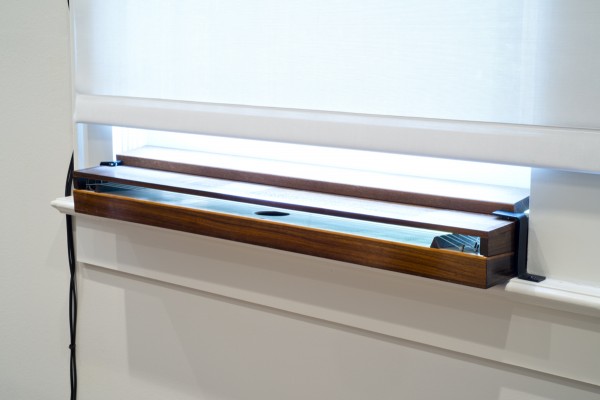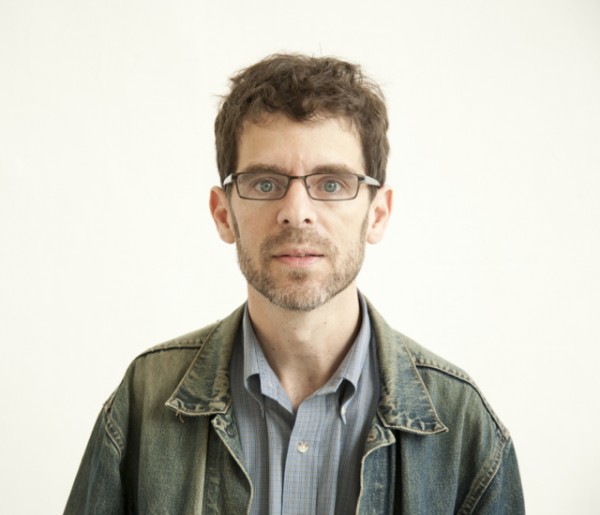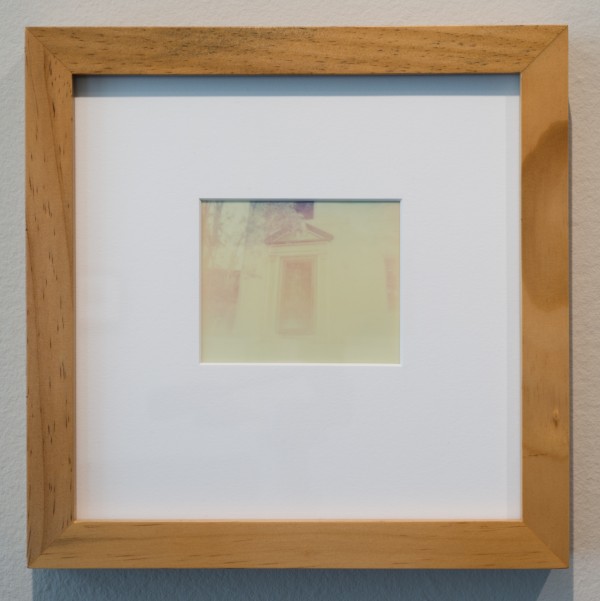Stephen Vitiello is a sound artist who teaches at Virginia Commonwealth University. He has exhibited around the world and collaborated with artists such as Pauline Oliveros, Tony Oursler, Julie Mehretu, Scanner, Nam June Paik and Steve Roden. Vitiellio’s first Texas solo exhibition was at Texas Gallery and the gallery has also produced the 2001 17:48 from the Texas Gallery and the 2008 LP Four Color Sound with Vitiello. He will present an upcoming project at the Menil Collection as part of the Silence exhibition that opens at the end of July. In conjunction with that exhibition, he will perform with Steve Roden at the Rothko Chapel.
Vitiello was in Austin last month to mount an exhibition at the house gallery, Testsite. (And the room into my buzzing head, curated by Lora Reynolds, is on view through August 5, 2012.) I sat down with him outside, where the birds and cicadas were chirping loudly, to discuss sound, archiving and collaboration.
Katie Geha: When did you know you were an artist?
Stephen Vitiello: It was over a period of time that I shifted from thinking of myself as a musician to thinking of myself as an artist. In the 1990s I did a lot of soundtracks for video art and still thought of myself as a musician and, sometimes when I wasn’t feeling too pretentious about it, a composer. But I was always starting form scratch, making my own sounds. I got to this point when I wanted to get out of my shell of always being a collaborator and at the service of visual artists.
There were a few things that happened. The Museum of Contemporary Art in Lyon, in France, wanted to do a retrospective of video works that I had done the soundtracks for and they said, “unless you make installations.” And I said, “Oh, well, I do make installations!” Larger projects were brewing in my head but I hadn’t had the opportunity to actually do my own works up until that point. It ‘s kind of a funny story, actually. I met with the curators and I was a little nervous. They said, “Well draw us a diagram of the space that you want.” So I drew this kind of free hand square and I put x’s where the speakers should go. When I got to Lyon for the opening, they said, “We made the room to your exact specifications and you’re so smart and so right. It shouldn’t be a perfect square, it’s much more acoustically interesting this way.” And I thought, “What?” And it’s this incredible thing that if you have receptive people they will listen and take you seriously. Having that installation there just felt like something new and something different.
I did a residency in the World Trade Center in 1999 and had my own studio and was there for six months. Initially, I thought I would primarily be making music, but the more I became connected to the actual environmental sound that I was capturing and not manipulating, the more my identity as an artist solidified. The open studio exhibition at the end of the residency led to exhibitions and, eventually to gallery representation. So it grew out of the process of discovery around 1999 and the sense of outside validation, of others saying, “of course you’re an artist.”

Installation view of Stephen Vitiello’s And the room into my buzzing head at Testsite. Photo by Colin Doyle.
KG: Do you feel like your practice as a musician and your practice as an artist are two different things? Or is it just the context in which each are presented?
SV: It’s really the context. I do think sound art has a relationship to music and visual art. One of the distinctions is space and context very much. There are sounds that I am making for this exhibition at Testsite that aren’t necessarily different than sounds I might use for a CD, but there are choices that are different in terms of duration and spatialization. The sounds that I made came out of a response to the space. Sometimes the actual sounds are not that different, but how time and space are treated is different.
KG: You collaborate a lot with video artists and filmmakers. How does collaboration inform your process?
SV: Collaboration, for me, was my whole education. From being young and starting out as a punk rock guitarist, and then playing in these other kinds of bands. At that point, I never thought outside of the box—you know a guitar is a guitar or a rhythm is a rhythm. It was around 1989 that the artist Tony Oursler invited me to collaborate. He asked me to do sound for an installation he was presenting in Holland. He just instantly started teaching me how to deal with space differently. He said, “Don’t worry if all these tapes are all in tune or the same length, instead try and figure out the concept of the piece and create a series of tracks that can co-exist. Let’s just see and hear how they sound overlapping or not overlapping.”
As I started working with him and other artists, I would try to mirror something about the quality of their work that I found interesting. If I was working with Tony not all things were perfectly in tune, or they might have a bit of an edge. I might be working with another video maker and the sound would be more precise. Or I would consider the manipulation they were using visually and try and find a correlation to it in sound. Not exactly the same but something that would work.
So that kind of observation with eyes and ears of other artists’ processes taught me a lot. For instance, I worked with Jem Cohen and seeing how he walked around the city with a Super 8 camera taught me a lot about eventually walking around the city with an audio recorder. It helped me figure out how I would create field recordings. So I know that I am going to this environment and I know I should bring a couple of mics but I don’t know what will happen. And not knowing is what makes it really interesting and relates to Cohen’s process. So from working with a variety of artists I was able to filter what was interesting to me.
KG: In terms of your field recordings, how do you create a structure or form? Or does the structure emerge after the recording?
SV: I think it always emerges after the recording. Sometimes in the process of recording you recognize an instance, a jolt, a “that was something,” and remind yourself to go back to that instance when the birds were singing and someone laughed and there was a third sound. I guess what happens with field recoding is that you’re recording raw content but somewhere within there exists a narrative. And if you’re patient and lucky and well attuned to the environment, you can sense when that narrative happens and frame it with editing later. Sometimes I layer sounds and sometimes it’s just the sound as I captured it. Or, sometimes I’m layering three or four passes on top of one another. Sometimes I manipulate things and slow them down or change the pitch or modify them really dramatically. It’s really case-by-case.
KG: Your works seem to have a lot of backstory to them. Or at least a lot of research goes into each of your projects.
SV: I worked a lot as a media archivist. I worked at The Kitchen and worked with their video and audio archive. I also worked on Nam June Paik’s archive. So the act of collecting and documenting is just part of my background. It’s not that I document every part of my life, like my family, or my pets or just anything. I prefer to work within the structure of the project. For instance, when I did the project on the High Line in New York, A Bell for Every Minute, I wanted to capture as many bells from all over the city as possible. I wanted to see what would come from the research of learning about how bells affect city life or what cultures use bells. By the end of the project, there’s a hard drive that contains 120 bells that are named and are designated by the place where they are played. So there’s the act of collecting and then there’s a thought at some point that these sounds (or images) might be valuable to someone else some day.
KG: Also it’s a kind of way to map the city through sounds.
SV: Exactly. It’s a mapping and movement through space. There’s a life of its own because it’s attached to these things in the world. And maybe some of these sounds become a kind of memory that never happens again . . . The piece becomes determined by its space. For instance, the work at Testsite could be vastly different if I created it at the beach or in a denser, noisier city.
KG: How do the pieces change over time? For instance, how did your project for the World Trade Center alter after September 11th? How might the recording at this house change in relation to how the house changes?
SV: Sometimes I think about all the recordings of the World Trade Center that I made and all the ones I recorded over. Now I wish I had all of them. Not that I would necessarily put them out in the world but for my own research or if someone might want then for some purpose at some point. I wish I had all of those recordings.
KG: Tell me about the thinking behind your show at Testsite.
SV: Lora Reynolds invited me to do a show at Testsite and suggested I consider ideas surrounding the home for the project. I thought, “Well what could that be?” And I think, like with a lot of projects, you start with something that is too simple of an idea but it’s simple enough that it gets you going. So I was thinking about footsteps and the sounds of doors closing and, you know, things that have been done a million times before. But I thought, “Well, I’ll just start with that.”
It brought me back to the book called The Poetics of Space by Gaston Blanchard, which is this beautiful book where he talks about a kind of psychology of the home, and to each room. I opened up randomly to a page and there was a quote by Tristan Tzara: ”And the room into my buzzing head.” That quote made sense to me so I made it the title of this exhibition. That text became a beginning.
I was reading another book, Senses of Vibration: A History of the Pleasure and Pain of Sound by Shelley Trower. The book begins with a description of an Aeolian harp, an instrument that dates back to the 17th century. It’s an instrument that’s played by the wind and sits in a windowsill. It was at this time that Lora and Colin Doyle came to New York to see a show I was setting up and Colin said, “You know, my Dad built an Aeolian harp, have you ever heard of one?” And I thought, “Wow.” It was a pretty great moment. So Colin said his father would loan me the instrument and I knew, coming to Austin, that it would be one of the anchors of the show.

Aeolian harp from Stephen Vitiello’s And the room into my buzzing head at Testsite. Photo by Colin Doyle.
KG: How did the harp turn into the audio recording? Did you manipulate the sounds a great deal?
SV: I recorded several hours of the harp passively, onsite. I would set it to record from 5:00 to 7:00 A.M., or I’d go to dinner and set it to record from 7:00 to 8:00 P.M. I thought about manipulating the recording, but then I was more interested in layering real-time passes. So it’s the cicadas, the birds, traffic, all of that is layered into the sound piece.
KG: What about the photographs?
SV: I brought with me to Texas a Polaroid camera with some very old as well as new stock, and thought I would take pictures that are somehow related to the creative process around capturing the sounds or listening to the house. I found that the pictures weren’t doing what I thought they would do, but that it was nice that they turned out so washed out. They become something totally distant and maybe almost like the manipulation I might have done with the sound. There’s one of the house, a cactus in the yard. I also feel like Polaroids have a nice relation to field recordings. The kind of process of gathering sound and it’s no longer tape, it’s faster than tape. This immediate turnaround of an image or a sound.
There are also drawings in the dining room that date from 2006. Lora suggested these LFO Speaker Drawings. Like the Polaroids that visualize the process of my recording, these drawings are created through sound and vibration. I had a speaker that I would put drawing materials on top of and then I would play these low vibrations and that would create the drawings. I hope that these drawings don’t dominate the listening experience. Rather than staring at something and thinking the sound is just in support of the image, ideally, you see the Polaroids and you just listen.
____________
Katie Geha is a writer, curator, and art historian living in Austin, TX. She grew up in Ames, IA and received her MA in art history from the Art Institute of Chicago. She is currently a PhD candidate in art history at the University of Texas, Austin. She runs the apartment gallery, SOFA.






2 comments
Very interesting interview. I’m enjoying this blog very much!
Nice reading 🙂